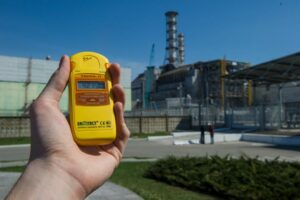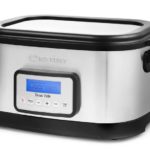A dosimeter is a device that measures radiation

blog.uaid.net.ua
A dosimeter is a device whose operating principle is to identify sources of increased radiation and signal a violation. In our article we will describe in detail where the device is used to measure radioactive radiation and how to choose it.
The content of the article
How the dosimeter works: its design
Each dosimeter works in the same way. The basic element in the design is a radiation sensor. According to the principle of its operation, sensors can be divided into:
- Ionization – consists of gas-filled chambers. When passing through the chamber, negative particles ionize the gas, causing irritation. They are recorded in the device and displayed on the display. Such devices are used to measure gamma and beta radiation. They act poorly on alpha radiation. A common design of a gas-discharge dosimeter is a Geiger-Muller counter.
- Scintillation crystals – based on organic or inorganic material. If charged particles pass through the crystal, then this burst is recorded by the device and displayed on the display. Used in search operations. Expensive and very heavy.
- Semiconductor sensors – consist of a crystal and a semiconductor. The action is based on changes in the conductivity of the material when charged particles hit it. Used to detect all types of radiation. Low cost and small size completely cover a small error in measurements.
Now you know the name of the radiation measuring device, depending on the built-in sensor. Next, let's talk about the criteria for choosing a radiation meter.
Why do you need to buy a device that measures radiation?
For domestic purposes - an individual solution. But in everyday life there are situations when you simply cannot do without a dosimeter. For example, you are walking through the forest and see an ordinary-looking nail. Just where he came from is unknown.
Even a couple of minutes near such a nail can lead to great negative consequences if it is irradiated with radiation. Therefore, even walking through a city or a remote unmarked object can still result in a radiation dose.
Standard dosimeters are issued to employees of the chemical and radiation industries. It's like a piece of equipment - you don't need to buy anything.
What is a dosimeter and how to choose it when you don’t know what and where to look
To choose one or another model of the device, you need to know: what type of radiation you will be in contact with and how often the situation needs to be analyzed.
Among all the options, alpha, beta and gamma radiation can be encountered in everyday life. The most dangerous for all living things is alpha.
It is more difficult to determine than others, since the device must be brought close to the radiation source. The fact is that alpha rays propagate at a distance of 2-3 cm. For this you need a Geiger dosimeter with additional sensors.
If you have the necessary funds, then the best option is to purchase a model for measuring three types of radiation at once.
For basic use, a dosimeter-radiometer is sufficient. It is sufficient to detect gamma and beta rays. With such a device you can measure the room and environment at least daily.It is also not a sin to look at food products, vehicles and building materials - they are moving throughout the country. You never know what it will bring from the other end of the region.
The following parameters will help you choose a specific model of dosimetric equipment:

- Tunderlying detector type – the main technical characteristic that affects the degree of measurement efficiency and the accuracy of the result. Between a semiconductor and a gas Geiger detector, it is better to choose the latter.
- INtypes of radiation we are going to measure – devices specialize both in a specific type and several at once. To measure one type, on a multifunctional one it is worth constantly switching the operating mode. For this purpose, separate buttons or a regulator are provided. A primitive option is a beta radiation detector. The optimal situation is when the dosimeter works in three main directions at once: alpha, gamma and beta.
- Result error – the accuracy of the device directly depends on this parameter. The smaller the error figure, the better and better the device shows in practice. For a household appliance, it is normal for the percentage of error to be about 25-30%. The tool is not suitable for professionals, as almost ideal values are needed. An error of 5-7% will be optimal.
- Range of values – maximum and minimum dosimeter positions that can measure background radiation. Pay attention only to the lower mark - it should not be less than 0.05 μSv/h. The maximum value is enough for any device. Especially for home measurements.
- Device verification – special mark from the factory. Indicates that the device gives accurate readings and is manufactured in accordance with all standards, GOSTs, etc. It is advisable that the verification be included in the equipment passport.As a last resort, a QC (technical control organization) mark from the manufacturer is sufficient.
Other parameters do not directly affect the operation of the device. These include: weight, appearance, fastenings, etc. They help simplify the measurement, but do not affect the performance of the dosimeter.





